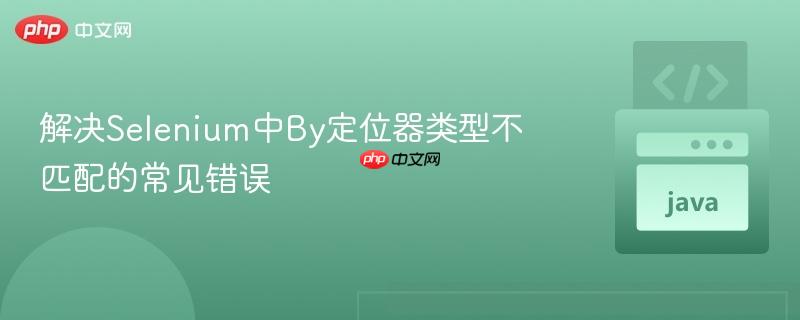
本教程旨在解决selenium自动化测试中,因错误使用`by`定位器导致的类型不匹配问题,特别是`'id(java.lang.string)' in 'org.openqa.selenium.by' cannot be applied to '(org.openqa.selenium.by)'`这一常见错误。文章将详细解释`by`对象的使用机制,并通过示例代码展示如何正确传递定位器,以确保selenium api的正确调用和测试脚本的稳定运行。
理解Selenium中的By定位器
Selenium WebDriver通过org.openqa.selenium.By类提供了一系列静态方法来定义元素定位策略,例如By.id()、By.name()、By.className()、By.xpath()和By.cssSelector()等。这些方法的核心目的是根据给定的定位值(通常是字符串)创建一个By类型的对象。这个By对象封装了定位元素所需的策略(如“通过ID定位”)和具体的值(如“user-name”),它本身并不是元素,而是描述如何找到元素的“蓝图”。
例如,By.id("user-name")会创建一个By对象,指示Selenium去查找ID为“user-name”的元素。
错误分析:类型不匹配
当您在Selenium自动化测试中遇到错误信息'id(java.lang.String)' in 'org.openqa.selenium.By' cannot be applied to '(org.openqa.selenium.By)'时,这明确指出By.id()方法期望一个java.lang.String类型的参数(即元素的ID值),但实际传入的却是一个org.openqa.selenium.By类型的对象。
这种错误通常发生在尝试将一个已经封装好的By对象再次作为参数传递给另一个By工厂方法时。换句话说,您可能已经有了一个By对象,但却错误地尝试用By.id()或其他By方法再次“包装”它。
错误用法示例
以下Java代码片段展示了导致上述错误的一种常见模式:
package adta;
import org.openqa.selenium.By;
import org.openqa.selenium.WebDriver;
import org.openqa.selenium.support.ui.ExpectedConditions;
import org.openqa.selenium.support.ui.WebDriverWait; // 假设BasePage或LoginPage有WebDriverWait实例
public class LoginPage extends BasePage { // 假设BasePage提供了WebDriver和WebDriverWait实例
public LoginPage(WebDriver driver) {
super(driver);
}
public By getUserNameLocator(){
return By.id("user-name"); // 此方法正确地返回一个By对象
}
public void open(){
driver.get("https://www.saucedemo.com/");
}
public boolean isLoaded(){
// 错误用法:By.id()期望String,但getUserNameLocator()返回By对象
// 相当于 By.id(By.id("user-name")),这是不合法的
return wait.until(ExpectedConditions.visibilityOfElementLocated(By.id(getUserNameLocator()))).isDisplayed();
}
public void login(String username, String password) {
// 错误用法:同上
driver.findElement(By.id(getUserNameLocator())).sendKeys(username);
driver.findElement(By.id("password")).sendKeys(password);
driver.findElement(By.id("login-button")).click();
}
}在上述isLoaded()和login()方法中,getUserNameLocator()方法已经返回了一个完整的By对象(例如By.id("user-name"))。然而,开发者又试图将其作为参数传入By.id()方法中。由于By.id()方法只接受一个字符串作为元素的ID,这种嵌套调用导致了类型不匹配的错误。
正确使用By定位器的原则
理解核心:By类的静态方法(如By.id()、By.xpath()等)用于创建一个By对象。一旦这个By对象被创建,它就应该直接传递给那些期望By类型参数的Selenium API方法,例如:
- WebDriver.findElement(By by):用于查找单个元素。
- WebDriver.findElements(By by):用于查找多个元素。
- ExpectedConditions.visibilityOfElementLocated(By by):用于等待元素可见。
- ExpectedConditions.presenceOfElementLocated(By by):用于等待元素存在于DOM中。
当一个方法(如getUserNameLocator())已经返回了一个By对象时,就无需再使用By.id()或其他By方法对其进行包装。
修正后的代码示例
以下是修正后的LoginPage类代码,展示了如何正确使用getUserNameLocator()方法返回的By对象:
package adta;
import org.openqa.selenium.By;
import org.openqa.selenium.WebDriver;
import org.openqa.selenium.support.ui.ExpectedConditions;
import org.openqa.selenium.support.ui.WebDriverWait; // 假设BasePage或LoginPage有WebDriverWait实例
public class LoginPage extends BasePage { // 假设BasePage提供了WebDriver和WebDriverWait实例
public LoginPage(WebDriver driver) {
super(driver);
}
public By getUserNameLocator(){
return By.id("user-name"); // 正确返回一个By对象
}
public void open(){
driver.get("https://www.saucedemo.com/");
}
public boolean isLoaded(){
// 正确用法:直接将By对象传递给visibilityOfElementLocated()
return wait.until(ExpectedConditions.visibilityOfElementLocated(getUserNameLocator())).isDisplayed();
}
public void login(String username, String password) {
// 正确用法:直接将By对象传递给findElement()
driver.findElement(getUserNameLocator()).sendKeys(username);
driver.findElement(By.id("password")).sendKeys(password); // 此处By.id("password")是正确的,因为它直接接收字符串
driver.findElement(By.id("login-button")).click();
}
}在修正后的代码中,isLoaded()方法直接将getUserNameLocator()返回的By对象传递给了ExpectedConditions.visibilityOfElementLocated()。同样,login()方法也直接将getUserNameLocator()返回的By对象传递给了driver.findElement()。这样就避免了类型不匹配的问题,使代码逻辑清晰且符合Selenium API的使用规范。
关键要点与最佳实践
- 理解参数类型: 在使用Selenium API时,务必清楚每个方法期望的参数类型。By.id()、By.xpath()等方法期望的是字符串类型的定位值,而driver.findElement()、ExpectedConditions.visibilityOfElementLocated()等方法则期望By类型的对象。
- 封装定位器: 将定位器封装在单独的方法中(如getUserNameLocator())是一种良好的实践,它提高了代码的可维护性和可读性。当元素定位策略发生变化时,只需修改一个地方。
- 避免冗余包装: 如果一个方法已经返回了一个By对象,就不要再用By.id()等方法对其进行二次包装。这不仅是错误的,也是冗余的。
- 阅读API文档: 当不确定某个方法的参数类型时,查阅Selenium WebDriver的官方API文档是解决疑问最直接有效的方式。
总结
通过本文的学习,我们深入理解了Selenium中By定位器类型不匹配错误的根源及其解决方案。正确理解和使用By对象是编写健壮、可维护的Selenium自动化测试脚本的关键。遵循API的参数类型要求,可以有效避免此类常见错误,提升测试代码的质量和执行效率。






























